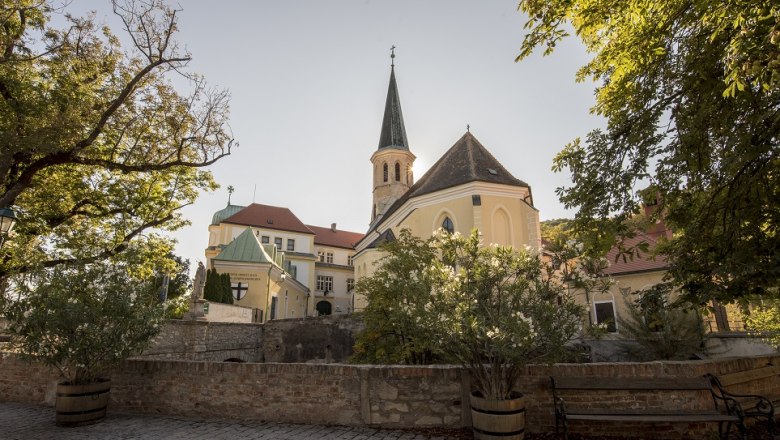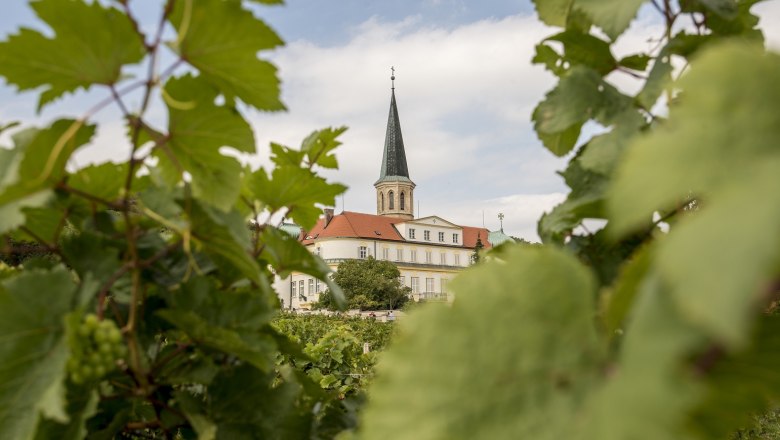Parish Gumpoldskirchen
Description
Gumpoldskirchen is first mentioned in a document in 1140, but it certainly existed for some time before this date - unfortunately the history books don't tell us anything about it. The same applies to the parish of Gumpoldskirchen. Here, too, we do not know when it came into being, whether it was independent from the start or whether it initially belonged to a neighboring parish. The first signs of its existence date back to the 13th century.
Today, the parish of Gumpoldskirchen belongs to the ecclesiastical district of "Dekanat Mödling" in the administrative unit "Vikariat unter dem Wienerwald". Our parish church rises picturesquely at the foot of the Anninger, where it forms an inviting ensemble of buildings together with the castle of the Teutonic Order.
Whether the defensive character of the parish church, the remains of which are still visible today, was already realized under the Babenbergs or only under the sovereignty of the Order has never been determined with certainty. The current building dates from the first half of the 15th century. On July 31, 1241, the last Babenberg, Frederick II, transferred the patronage of the church and parish to the Teutonic Order. Pope Aexander IV confirmed this donation in 1261. Since this time, the parish has been pastored by the Order. The church itself is dedicated to St. Michael.
The last war damage to the tower and church roof was repaired in 1947 and the interior was extensively renovated. After a general renovation of the interior in stages between 2004 and 2006, the church shines in its current bright splendour. The festive rededication took place at the end of September 2006.
Since 2008, a Gothic labyrinth has complemented the harmony of the parish church and castle. Visitors and locals alike enjoy taking a meditative stroll through the labyrinth and incorporating it into the proceedings at various celebrations.
Interior
This is one of the treasures of rural Gothic architecture in Lower Austria. Its rhythm is determined by slender, octagonal pillars, on which rest cross-ribbed vaults in contrasting colors. The choir is separated from the rest of the church by massive pointed arches. When the churches had to be completely renovated after 1683, St. Joseph's Chapel on the left aisle was redesigned in Baroque style, while the baptistery on the right aisle was given a portal richly decorated with stucco and dated 1691.
High altar, sculptures, pulpit
The Baroque high altar consists of an altar table clearly set back from the choir wall and wall architecture structured by flat pilasters. The altar table is adorned with a gilded tabernacle with worshipping angels. The altarpiece commemorates the patron saint of the church, the belligerent archangel Michael. It shows him as the conqueror of God's enemies. Stone sculptures of St. George and St. Elizabeth, the patron saints of the Teutonic Order, are attached to the picture as assistant figures. The expressive stone sculptures of St. John the Evangelist and St. Peter look out from consoles attached to the walls. These were created in the early 15th century.
The magnificent pulpit was added to the church in 1779. The image of the sower on the pulpit basket is a parable for the sowing of the word of God.
Painting
The two side altarpieces on the pillars in front of the choir correspond with the high altarpiece. The accompanying baroque altar tables were removed during a church renovation and replaced with simple lecterns.
The crucifixion deviates from the usual scheme in that the traditional accompanying figures have been replaced by the poor souls in purgatory.
The painting of St. Barbara is captivating due to the luminosity of its colors. The saint is kneeling in festive costume on a cloud bank and holding her attribute, the chalice with the host, in her left hand. She is surrounded by several angels. The angel on the right carries the sword with which Barbara was beheaded. The beheading itself is depicted in the lower third of the picture.
The balanced composition and skillful use of colour make the painting of the Holy Family in the Chapel of St. Joseph in the left aisle a jewel of Baroque painting. The signature names the painter as "Eques de Routier". The subject: Joseph and Mary are trying to find the boy Jesus. Mary is dressed as a city dweller, while Joseph is dressed as a farmer.
To the left of the high altar hangs the large panel painting "St. Elisabeth and the Beggar". It once served as an altarpiece in the castle chapel. The fascinating luminosity of the colors and its religious and human content suggest that it was painted by a renowned artist. He painted the beggar in front of Elisabeth with particular affection. The joyful glow that flits across his face reveals the transformed power of charity.
In the tower chapel there are two votive paintings by the local painter Franz Bilko (1894 - 1968): a fresco with Christ and the disciples of Emmaus and a panel painting of St. Jude Thaddeus with a view of Gumpoldskirchen in the background.


